#nuclear waste bin
Text

i forgot i drew thus like two months ago😭
395 notes
·
View notes
Note
Juicceeeee can you please give me an invite back to Chaos
I decided to be dramatic and leave but now I regret it :(
Oh- yeah holdon /lh
#digging in my nuclear waste bin for the pink i dropped /j#link#i meant link#i didnt drop pinkie pie in the radiation swear-#i forgot how to make private posts f u c k
0 notes
Text
DANCE MARATHON EPISODE (AKA MURDER ON THE DANCE FLOOR)-PART 5
After a quick blowjob break out in the soon-to-be-bloodspattered Stars Hollow High football field, a certain homocidal maniac in a puke green church donation bin coat has returned, and he's ready to dish out some sass. Shane is not in tow yet, but we need to give her time to freshen up and make herself presentable for the remaining few hours of her life.

Lane's pointless bitterness towards Jess is such a fucking waste. My "Lane hates Jess for stupid reasons when they could have been pals" rant has been reheated in the metaphorical microwave too many times already, so I won't repeat myself, but yeah. It's still about that fucking car accident.
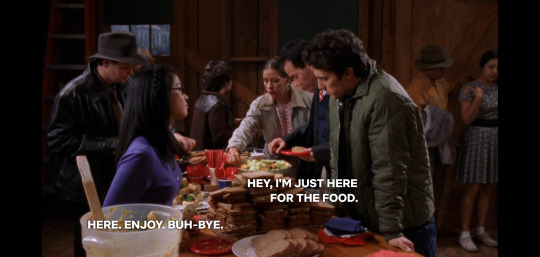
Getting your dick sucked on the high school football field before committing a gruesome homocide can really work up a boy's appetite.

Baby you're such a good noticer. *kisses forehead*

I can't think of anyone more deserving of a rock hard permanent public erection. Wait
And now, for what is possibly my favorite five-word exchange in the entire series:

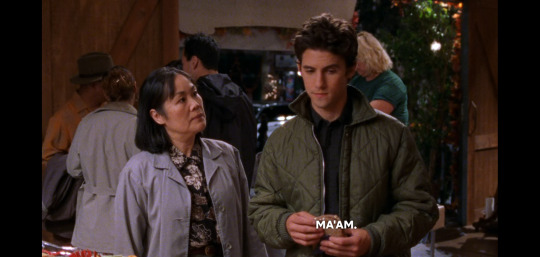
The most perfectly executed dry delivery. Ugh! Sheer perfection!
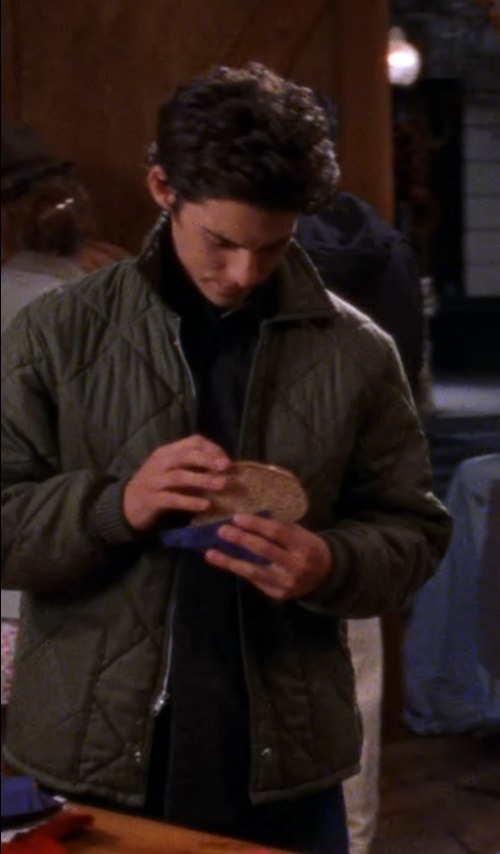
Well, at least egg salad sandwiches beat the Crack and Despair Sandwiches Liz used to pack in his lunchbox.

Miss "My Virginity Spared Me From Becoming Football Field Fertilizer" has arrived with Also-Not-Dancing Butthead in tow. If the food is for the dancers, I better not see him eat anything. I will smack that sandwich out of his hand so fast so help me god
(virgins always survive the killing spree).


You ever think about what a monstrous hell it must be for Jess living in a place like Stars Hollow? I think about this a lot. But I like to think that off screen he gets in his car and gets the fuck out of there as much as possible. Anyway, this is another perfectly dry one liner that I absolutely love. I want to fil out adoption papers and take all of his sarcastic one liners from this episode home from the shelter.
R: You have nothing better to do than sit in a gymnasum staring at a dance marathon?
J:Idk, do you have nothing better to do than sit inside a gymnasium staring at a dance marathon?
R:Do you think you're bugging me sitting in front of me and staring like that?
J: Do you think you're bugging me dancing and staring at me like that?
R: I'm not staring at you!
J:How do you know I'm staring at you?
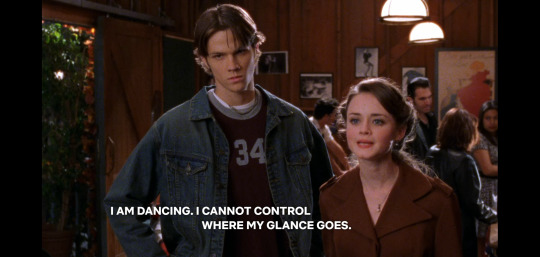
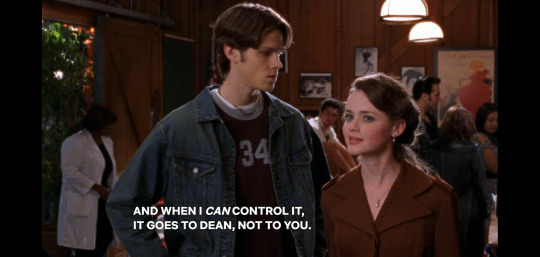
Dean: It's been two years. Maybe you can glance at my dick for once, Rory.
Has Rory ever said anything supportive of Dean that wasn't said with the same conviction as if she were a bank robbery hostage?
Deany has that constipated look on his face again. Is he sad because no one was staring at him? But someone was. I'll give you a hint, it's a certain MILF who wants to turn that 34 into a 69. Lorelai is 34 years old in this episode, by the way. He's proudly displaying his love of young milfs on his literal sleeve.
Listen, you could power Stars Hollow with the combined sexual frustration of these three people + Lane and Dave Ryglaski to make it extra nuclear. When nobody puts out, you get three teenagers eating egg salad and having an "I'm not staring at you!" argument in a school gymansium at 10pm.
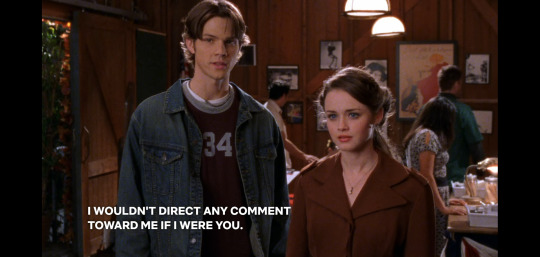
Ooooh. Jess is shakin in his little murder boots.
J: I'm supporting my town.
R: Go back to New York.
Oh Rory babe, if only he could, he'd be home now with a smile on his face with a pushcart hot dog in one hand while some easy alt chick rode his dick. Well, yeah he's got that now but he's going to feed her to the swans then take an 8 month vow of celibacy for some reason.

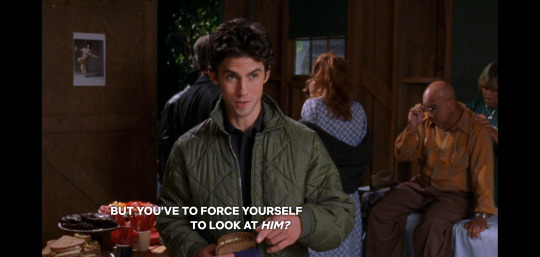
Got em.

He's so LAME.
Jared: Hey AmyShermanPalladino, can't Dean get any fun comebacks for once? Why does Milo get all the good sass?
AmyShermanPalladino: You can pick from the reject pile. We've got "my former comment still stands" "Are you trying to act tough, you're wearing a tie" and "You're the one who's going"
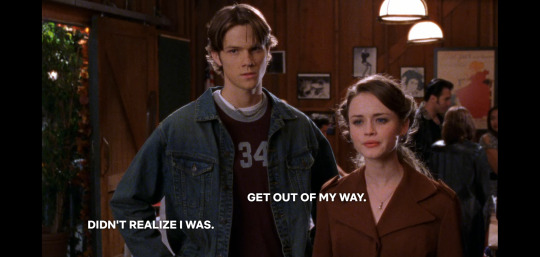
She's so horny. God help her.

Shane Campbell stars in the newest WB Network vehicle, "My Favorite Murder Victim."
He keeps picking at that sandwich like he's going to find a $100 bill in the bread.

You want this poor girl to spend the last precious hours of her life doing math problems?
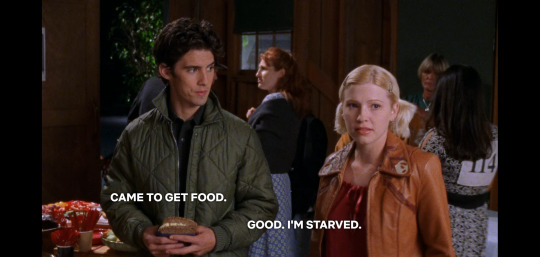
I guess egg salad will wash the taste of dick out of her mouth.

We heard you the first time, Ice Vagina.
What is Dean even doing here, lol.
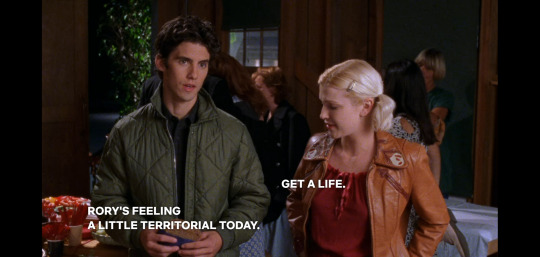
There's something incredibly erotic about this line.


Dean is like, what the hell is going on? Why is she touching me?

*immediately pushes her off*
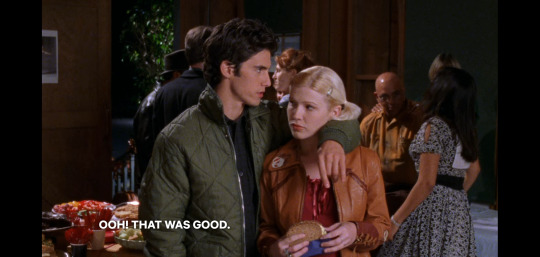
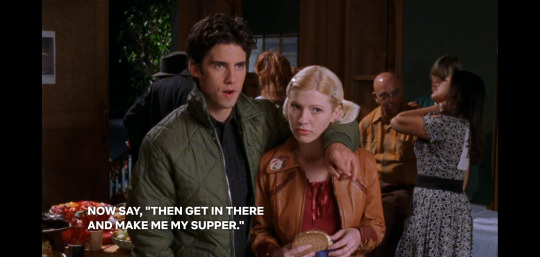
Don't give him any more ideas, Jess.
I just want to point out that on the table behind them, fresh fruit and brownies are available for consumption. You know you guys don't have to eat those sandwiches.

Code for "I'm gonna go find the murder implement I stowed away in the bushes earlier"
#gilmore girls#jess mariano#shane campbell#shane is swan food#denise rewatches gilmore girls#gilmore girls season 3#they shoot gilmores dont they#tsgdt#rory gilmore#I can't believe that like a half dozen people read this shit I write and don't unfollow me#bless your hearts#smoochies#I am fucked in the head#I even held back a few really insane things
39 notes
·
View notes
Text
This is not The End
It is entirely overwhelming, the state of the world. Climate Change, political corruption, corporate dystopia, hate and violence. It takes me by surprise how even knowing about a refugee on the other side of the world being sent back can affect me.
It is not The End. Even in an utterly worst case scenario, like nuclear war, it's not The End. There would be survivors, and those survivors would do everything they can to survive. But that's worst case, and we're far from that.
You've got a sense of powerlessness. You can't make Musk or Murdoch or The Koch's or a screaming orange colostomy bag stop what they're doing.
You know what you can do?
You can put out the recycling for collection.
You can compost your left overs in a tiny bin in your kitchen.
You can feed that plant by your window that's by all accounts is already dead.
You can sew a patch onto your torn trousers.
You can give your friend, neighbour, or stranger, a potato. Or a joke. Or a bit of advice you learned to be effective.
You can find an old book on carpentry, and learn how to fix that creaky step in your apartment.
But why do any of this while the world is burning? It is a complete waste of effort and energy, right?
It may be. Maybe there will never be enough of us to turn the world around. So why even try?
Because you are a world. We see things from our own point of view, where we are at the center. At that may sound selfish or egotistical. Don't do the good things for the other world, do it for your own world, and how you build it. Do the things that make your world better, your mind, your body, your home.
Build the bridges to other worlds. To your friends, your family, your lovers, your children, even to strangers. When you've gotten your world stable, help them with theirs, and maybe they'll help you too.
Make the nice food for yourself. Maybe share it.
Ask if anyone wants your old clothes, even just rags. They might have a use for them.
Keep the empty bottle in your pocket till you find a bin, or even collect others.
Pull out the weeds.
Put on sunscreen.
Fix your umbrella.
Look at all the photos you've taken.
Read.
Learn.
Try.
And do not fear failure. Absolutely no one is immune to failure. No one. Embrace the mistakes you make. Make them again. And again. Get it right and make a mistake again.
You are your own world that you can control and influence. And even if there aren't enough of us who try to make the world a better place, we'll have made our own better, and shown others they can too.
67 notes
·
View notes
Text
Great Men Academy
Y’all this is such a good show (she says to everyone who already watched it years ago). It’s Nadao Bangkok (RIP) so I knew production values would be high and the cast would be excellent, which was of course true. Love was a compelling character and I came to really love her, especially as portrayed by James. It was also more of an ensemble show than I realized, which gave us the opportunity to dig into some interesting stuff with Love’s brother Good and Love’s friends in the academy (Love, Menn, and Nuclear are such a good squad).

And as I discussed with @bengiyo, I thought the show was doing some really interesting stuff with gender identity and the stifling oppression of being forced to conform to either feminine or masculine ideals. Especially in the early parts of the story, Love felt much freer and more herself when she was able to live as a boy without having to perform femininity. And we saw the boys all battling with the confines of masculinity in their own ways. I loved that both versions of Love felt authentic and real and that in the end, Love got the chance to reconcile these two sides of her we’d seen throughout the story, and be loved and accepted in any body.
I only have one real complaint: this show needed a lot more Tangmo (and significantly less Vier).

Tangmo is an excellent person. He is kind. He is playful. He is funny. He is generous. He is loyal. He is basically head over heels for Love almost immediately after meeting her. He has himself a little queer awakening about it, works through his feelings privately, and then gets back to being a good friend and mentor to her even when she has hurt his feelings and rejected him. And he sees her for who she is rather than what body she’s occupying. He’s a fantastic character.
But sadly, there were long stretches in the middle of this show where he disappeared from my screen, mostly so we could spend lots of time with Vier’s daddy issues and ex. And I gotta be honest, fam. I don’t care. I recognize that they made us spend all that time with Vier so we would have some empathy for him when he keeps fucking over his best friend for the sake of winning this competition, but for me at least, that was time mostly wasted. I didn’t much care about the details of his feelings for Rose (the best parts of that plot had to do with Sean, and I was honestly so glad to see them let go of Vier at the end), and I did not find his issues with his dad particularly compelling. None of it engendered enough sympathy in me to forgive him for intentionally using Tangmo’s feelings for Love against him. If I were Tangmo I’d be putting this “friend” in the trash bin.

I would have appreciated seeing some of that story time used to give a bit more depth to Love and Tangmo’s relationship. By the time Tangmo confessed properly, Love had clearly developed feelings for him and wanted to accept him. And she cared about him enough in the end to give up her wish to make sure he lived. But for me, it didn’t feel like we really saw the moment when Love’s feelings for Tangmo changed, because she and the narrative were too focused on Vier. As a result, while I thoroughly enjoyed the end of their romantic arc, it felt like some connective tissue was missing to make it really feel earned. If I could change one thing about this show, it would be that.
23 notes
·
View notes
Text

Mrithun is done!!!!!! He makes my eyes hurt and I love him for it
I had literally so much fun designing him, I think is my favourite character design I’ve ever made literally for anything.
He’s got chemical burns on his knees!! That’s actually the origin of his slipping stick-man patch. He accidentally slipped on some dangerous chemicals and got them on his knees. He thinks they look cool though.
Very autistic, special interest is any and all kinds of poisons.
Owns a garage-like lab, where the only light is the sunlight pouring in from his very high up windows. He’s got a lot of them, just in case he needs to vent out any dangerous aromas/vapours. It’s chilly in his lab, but he’s always at the very least room temperature. If he has anyone he has taken interest in in the lab, he would offer to help warm them up with his own body heat.
Loves loves loves collecting patches that he can even vaguely relate to poison. Has two patches (visible in this photo) that are in relation to nuclear waste sites andwarnings for future civilisations. He has a patch depicting large spikes jutting from the ground, and a patch that says “This is not a place of honour”.
He also has a patch of the Monkshood/Wolfsbane flower, which is one of my favourite flowers :)
If it were possible to dye your entire mouth a colour, he’d dye his silver like mercury.
ALWAYS has poisons on his person. Will never be able to get through customs unless literally bribed to take the poisons off. Even then he would NOT let the customs people take his poisons and just dump them out in some waste bin. If he plans on travelling, he’ll have to hide/stash his poisons somewhere in his lab before setting out to do so.
Pokémon Team:
Alolan Muk
Crobat
Scollipede
Roserade
Seviper
Garbodor
and an additional Grafaiai.
#mandjtv#Mrithun#Mrithun (Mikeyverse)#Poison Type Mikey#Eyestrain warning#tw eye strain#tw eyestrain#cw eye strain#cw eyestrain#eye strain tw#eyestrain tw#eye strain cw#eyestrain cw#bright colors#tw bright colors#cw bright colors#bright colours tw#bright colors cw#eye strain#eyestrain#eye strain warning#eyestrain warning#THERES SO MANY TAGS FOR THIS#I want to kiss him on the mouth
7 notes
·
View notes
Note
Where do you get your facts about nuclear stuff from? Do you have other facts about it to share? It's so cool to hear about ^^
I just go down random rabbit holes when I research for Sim Spring. So all my sources are different and a lot of it is from journals or articles.
Mmmh here's one (related fo nuclear history but is more abt radioactivity): In the late 90s, the US Department of Energy noticed a weird breach in Washington when health monitors recorded radioactivity from a mobile trailer. They noticed that their Geiger counters picked up specks of of radiation throughout the air, light switches, a cutting board and pieces of silverware. It then started to breach out of the trailer, onto dirty laundry, tobacco and garbage bins miles away. The material had been spreading through flies. Flies who were hatched from eggs that sat on top of concrete containers of nuclear waste around Hanford. These irradiated flies would spread miles away from the Hanford site, into homes. There was a private clean up effort and in a Q&A sessions, management would strongly advice people to keep their food in closed containers. This incident raised some of the early concerns about how radioactivity knows no borders, and can easily breach containment.
24 notes
·
View notes
Text
Man, I am 2 for 2 on fun conversations with ~randos in my neighborhood.
Waiting in line to get an afternoon coffee, I overheard two men, a beared white guy and a goateed Asian-American guy, talking about neurodivergence and then military IQ tests.
Usually, when I hear people discussing IQ tests in public, at least if they're dicussing their own IQ scores, I tentatively bin them as weird dick-measurers. But...this felt different, and so I broke into their conversation.
I mentioned that Bobby McNamara, our secretary of defense under LBJ, expanded military induction to low AFQT scorers during the Vietnam War, which resulted in many of those low scorers getting killed on the battlefield due to inability to understand battle conditions and difficulty following complex directions, and how this was widely regarded as awful public policy by those who understood it.
One of the men I was speaking to said this didn't surprise him; he and his conversational partner had been in a program where "NUKEs" (Naval nuclear technicians, who were drafted from the top echelon of AFQT scorers) were trained alongside low test performers, and the on-the-job differences between the two cohorts were really obvious. Everyone who works on a US Navy submarine, all of which are nuclear-powered, is a high AFQT scorer because there's lots of technical material to absorb in training, delicate chemical tests need to be carried out, complex safety protocols need to be followed, etc., and AFQT scores statistically predict competence in such roles well.
The mention of nuclear technical programs piqued my interest, so I asked him more. He said he received some training on reactor operation but was never stationed on a sub. Then I asked him if he was familiar with the Air Force's nuclear-powered aircraft program. That got him visibly excited, which got me excited. We talked about the molten salt coolant and the fuel dissolved in it.
The Asian guy asked how the reactor was used to propel the plane. Racking my brain, I said the reactor creates a heat gradient, which has to drive a propeller housed in an engine cowling. I was missing a vital detail that the hot coolant runs though a heat exchanger positioned in the compression chamber; this raises pressure, and a turbine uses the pressure to drive a shaft to compress the incoming air (which, I presume, raises efficiency). Whenever you have a temperature gradient, I said, you can harness it to do mechanical work—at once true and a punt.
I was gonna bring up reprocessing when the Asian guy asked if damage to the aircraft reactor would turn the aircraft into a dirty bomb. The white guy said the molten salt reactor is inherently safer than widely-used light water reactors because it's kept at atmospheric pressure and is already liquid so cannot melt down. There's nothing to disperse the material. Plus, said the white dude, there's far less waste (mid-long lived radionuclides, all of which are actinides, are burned off during operation).
Very excited now, I brought up the suitability of molten salt reactors for use with the thorium fuel cycle that breeds thorium-232 into uranium-233 for fissile material, making better use of a more abundant material with less proliferation risk. The white guy looked very happy.
He asked if I knew all this because I was interested in a military career. "Not particularly," I said, "I'm just a technology enthusiast. I've been on a nuclear engineering kick for the past couple of months." I had a brief flash of fear that I came across as a foreign intelligence agent.
They said they needed to head out. I asked them if they lived in the area. "Yeah, we live around here. We come by in the afternoon every so often for coffee."
Though I'm happy I'll be moving soon, I realize I'm going to miss this area. Why didn't I start meeting these people three years ago, damn it? Also, moral of the story: talking to people talking about IQ tests may lead to nuke conversations, which are fun.
6 notes
·
View notes
Text
MJ: Research part 2

- According to Statista's ocean pollution by country report, in 2010, China was responsible for 8.8 million metric tons of mismanaged waste, with an estimated 3.53 million metric tons ending up in the oceans.
- Despite having the largest population globally, China aimed to recycle 35% of its plastic waste by 2020.
- Indonesia, with a population of 264 million, had 3.2 million tons of mismanaged waste, resulting in 1.29 million tons entering the oceans.
- The United States, with 327 million inhabitants, contributed 0.11 million metric tons of waste to ocean pollution.
- In 2010, both China and Indonesia accounted for over a third of the world's plastic waste, as reported by the Wall Street Journal.
- The ocean pollution statistics by country report was conducted by a team of researchers from Australia and the United States, led by Jenna Jambeck, aiming to analyze global levels of plastic waste in the oceans.
What are the causes and what is marine pollution?
80% of pollution in our oceans comes from land-based sources.
Most developing countries dispose of 90% of water, and 70% of industrial waste gets discharged into our oceans without treatment.
We produce 100,000 chemicals commercially – all of which threaten the ocean through transport accidents and leaking into the soil or atmosphere to reach the sea.
1950-1998 over 100 nuclear blast tests occurred in our oceans.
50% of the world’s ship cargo is considered dangerous to the environment; 90% of the planets international trade is transported by ship.
6,000 offshore gas and oil installations provide 30% of the world's energy supply.
The gas and oil industry releases greenhouse gases and causes thousands of spills annually.
Oil spills are vastly dangerous to the oceans, but only 12% come from actual spills – the rest leaks in from drains and rivers.
3,000 different marine species are transported around the planet in 12 Billion tons of ballast waters, causing significant problems with invasive species entering marine ecosystems.
In the Baltic sea alone, over 100 alien species are impacting marine life.
80% of global marine pollution comes from agriculture runoff, untreated sewage, and discharge of nutrients and pesticides.
Coastal areas are significantly impacted by fertilizer runoff from lawns and farms. These nutrients cause algal blooms to flourish and dissolve the water's oxygen levels.
These harmful algal-based blooms have tripled since 1984, closing beaches and killing fish.
Annually, the Mississippi River flows 1.5 million tons of nitrogen pollution into the Gulf of Mexico.
The U.S. Navy uses a high-intensity sonar for training – this has been linked to whale strandings.
Marine pollution causes 1: discarding materials that can be recycled
- Recyclable materials disposed of in regular bins instead of being recycled can end up in landfills.
- Some countries lack recycling programs, further contributing to this issue.
- When recyclable items are deposited in landfills, toxins can leach into the soil and eventually reach the ocean through rivers.
- Lightweight plastics, in particular, are prone to blowing away during transportation or from landfills, potentially ending up in drainage systems and rivers, ultimately polluting the oceans.
Marine pollution causes 2: everyday littering
- When plastics and other potentially toxic materials are littered, drainage systems and rivers transport them to the sea.
- Rainwater or wind can facilitate the movement of litter into drainage routes leading to the ocean.
- Illegal dumping of waste exacerbates this issue on a larger scale than individual littering.
Marine pollution causes 3: products and chemicals that go into our drains
- Many people improperly discard everyday products like sanitary products, cotton buds, and wet wipes down the toilet.
- Additionally, people may not realize that washing clothes made from materials classified as plastics releases microfibers, which also find their way into our drainage systems and ultimately reach the sea.
Where does most of the ocean pollution come from?
90% of the global ocean debris comes from 10 rivers alone.
8 in Asia: Amur, Indus, Pearl, Yangtze, Yellow, Ganges, Hai He, Mekong;
2 in Africa: Niger and the Nile.
Tops 10 rivers
1,469,481 tons - Chang Jiang (Yangtze River)
164,332 tons - Indus
124,249 tons - Huang He (Yellow River)
91,858 tons - Hai He
84,792 tons - Nile
72,845 tons - Meghna, Brahmaputra, Ganges
52,958 tons - Zhujiang (Pearl River)
38,267 tons - Amur
35,196 tons - Niger
33,431 tons - Mekong
- Dr. Christian Schmidt and his team conducted research to identify the entry points of ocean pollution, particularly focusing on the sources of plastic pollution.
- Over the past decade, researchers analyzed waste in the water near 57 major rivers that flow into the oceans.
- Their study revealed that 10 rivers are responsible for 90% of the plastics entering the oceans.
- Schmidt and his team calculated waste quantities per cubic meter and compared them across the 57 rivers studied, identifying the top 10 rivers with the highest plastic pollution levels.
- Eight of these rivers are located in Asia: the Amur, Indus, Pearl, Yangtze, Yellow, Ganges, Hai He, and Mekong. The remaining two are the Niger and Nile rivers in Africa.
How does ocean pollution affect humans?
Coastal water contamination is responsible for 250 million clinical cases of human diseases annually.
Only 1 in 20 adults bathing are at risk of becoming ill after a single bathing visit in waters considered ‘acceptable’ by microbial standards.
At the current rate, by the end of the century, our waters will be 150% more acidic than now.
80% of sewage discharged into the Mediterranean Sea is untreated.
Contaminated shellfish is the cause of 50,000-100,000 deaths annually due to damaged immune systems and cancer.
People who primarily eat seafood as their diet like indigenous people of the Canadian Arctic and Greenland are found to be contaminated by POPs (Persistent Organic Pollutants).
100% of the population of East Greenland has blood contamination.
The direct medical and health costs of polluted waters are $16 Billion globally each year.
Economic losses due to non-indigenous species getting introduced into the ocean are in the 100’s of millions of dollars.
70% of the oxygen we and other land animals is directly from the sea.
- Man's survival hinges on a harmonious relationship with the planet's oceans, as over 70% of the oxygen we breathe is produced by marine plants.
- Activities on land directly impact offshore environments; for instance, 30% of our CO2 emissions are absorbed by oceans, while waste disposal affects the ecosystem and wildlife toxicity.
- Ocean pollution poses significant risks to humans, contaminating seafood and water supplies with plastics, metals, and chemicals.
- The bacteria in polluted water interact with disposed metals like mercury, converting them into highly toxic forms.
- Marine plant life absorbs these toxins, which then accumulate in fish, a staple of human diets, resulting in the transfer of toxic waste up the food chain.
- Exposure to methylmercury, a byproduct of polluted waters, has been linked to serious health issues such as heart disease, Alzheimer's, and Parkinson's disease.
- Even swimming in polluted waters can lead to adverse effects like rashes, diarrhoea, and stomach aches.
0 notes
Text
Green Hat - New possibilities, alternatives
I wanted my green hat to be a representation of where we are presently with atomic energy, with many of us having the first thought of nuclear waste and the devastation atomic energy-related accidents have caused e.g. Chernobyl, Fukushima. I wanted to have flashes of what an ideal future could look like if atomic energy was harnessed as a green energy and used, in tandem with other green energies, to replace fossil fuels, almost as if the future was tearing through the current image.
I created these drawings in Photoshop to represent the growth of nature from this kind of energy and also atomic energy potentially being used on a large scale to produce electricity instead of fossil fuels. The leaves growing from the lightning strikes are what tie the natural aspect to the electric.
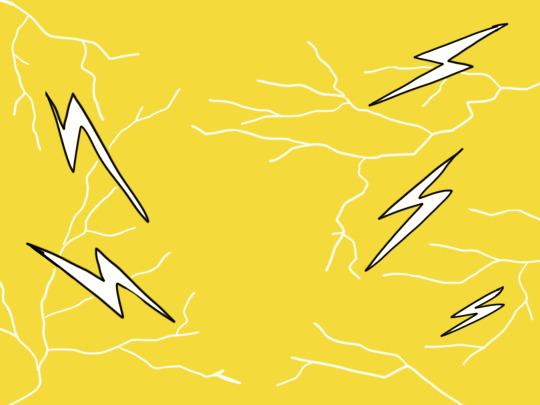
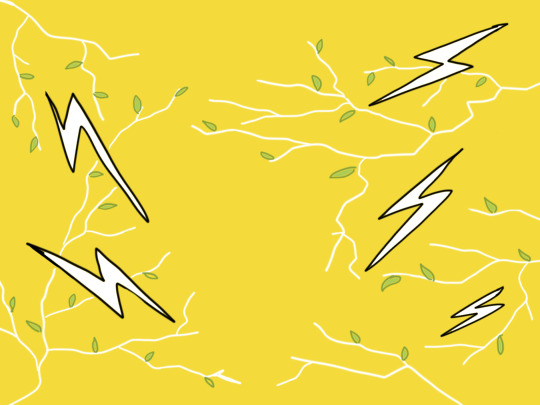


I created a 3D model of a toxic waste bin and damaged radioactive warning sign placed amid an idealistic patch of green grass against a sunny, blue sky. This was meant to be a 'perfect' version of what has been seen to happen at sights like Chernobyl, with animals returning to the area and Pripyat now looking like a forest that reclaimed the city.

The final video for now:
0 notes
Text

late cringetober angel x demon ,, this is prob the only prompt im gonna do x3
#sonic the hedgehog#shadow the hedgehog#sth#sonadow#sorry to anyone who sees this#funniest shit ive made#i was gonna make shadow the angel and sonic demon originally idk why i changed my mind lawl#nuclear waste bin
219 notes
·
View notes
Text
Lee County Waste-to-Energy Facility
The Lee County Waste-to-Energy Facility does exactly what its name implies — it takes the trash no one wants and turns it into something useful. All trash produced in Lee County and Hendry County is processed at the Waste-to-Energy Facility. Each person generates around 1 ton of trash; consider that the combined populations of these two counties are about 850,000, and that is a lot of trash! Population growth is becoming a concern - Lee County alone is predicted to have over a million residents by 2030 - because more people means more waste.

Photo taken by me.
The cities of Cape Coral, Fort Myers, and Sanibel coordinate their own garbage collections. There are four trash pick-ups weekly: household garbage, yard waste, bulk items, and recyclables. Recyclable items include paper, metal, cardboard, plastic, and glass, all processed at the Material Recovery Facility (MRF). Unfortunately, 30% of the material processed at the MRF cannot be recycled due to contamination. Educating citizens on proper recycling methods can help reduce contamination and improve recycling efforts. On the bright side, Lee County surpassed Florida’s recycling goal of 75% by 2020 with an impressive 80% recycling rate.

Photo taken by me.
Four main fuels exist: natural gas, coal, nuclear, and renewables. Natural gas is the most common, making up 43% of our fuel. Coal used to make up 75% of our fuel, but it has been reduced to 20%. Nuclear waste is the most controversial and expensive fuel type, making up only 9% of our fuel. The last 25% of the fuel we use comes from renewables, with hydroelectric power making up 9%, and solar and wind power making up the remaining 16%. Renewable energy sources are more sustainable because they do not burn fossil fuels or contribute to greenhouse gas emissions. The book “Sustainability Principles and Practice” states the following about renewable energy: “Solar and wind energy sources are intermittent. The sun does not shine at night, and the wind does not always blow. Hence, storage is a necessary element in most renewable energy systems. Possible storage media include batteries, pumped hydro, thermal storage, compressed air, and flywheels.” (Robertson, 2021, p. 208). Thanks to energy storage, we can always enjoy the benefits of renewable energy.
The Lee County Waste-to-Energy Facility adheres to the principle of “cradle to cradle.” According to “Sustainability Principles and Practice,” “The standard approach to product life cycle is sometimes referred to as cradle to grave, with materials and resources following a one-way trip from production to disposal…architect William McDonough and chemist Michael Braungart challenged the usual eco-efficiency approach to design thinking in their seminal book Cradle to Cradle…They proposed an alternative approach based on nature’s model in which waste equals food, with waste at one level becoming a nutrient at another level (McDonough and Braungart 2002)” (Robertson, 2021, pp. 342-343). Waste is not simply disposed of at the Waste-to-Energy Facility but turned into something valuable. Through the combustion of our waste, the facility generates 60 megawatts an hour, which is enough electricity to power its own campus as well as 30,000 homes!

Photo taken by me.
As Mr. Mueller at the Waste-to-Energy facility says, “We are trashy people.” Luckily, there are many ways to reduce the amount of waste we produce: for example, you can use reusable bags when you go grocery shopping, buy items in bulk, take the time to sort items into the correct recycling bins, avoid unnecessary plastic packaging, use a reusable water bottle, and much more!
References:
Robertson, M. (2021). Sustainability Principles and Practice (3rd ed.). Taylor & Francis Group.
0 notes
Text
One thing I have yet to be able to do is to replicate something from my wardrobe (normie or otherwise) even though I attempt to replicate cosplay costumes all the time. I suppose technically I did a copy of an AP jumperskirt just to see if I can do it and technically, sewing from commercial sewing patterns are making replicas of the example outfit or drawing on the front of the package. But I mean copying normal every day store-bought clothes that don’t come from commercially released patterns already. I think the biggest disadvantage to making your own clothes is finding good fabric. The ideal fabric was already bought by the company in mass quantities to make the item in the first place, and anything else of similar quality you can buy as the end consumer is so expensive, you might as well just buy the store bought item and save yourself the time.
But I have high hopes for making copies of whatever seems easy to recreate (probably not many with my middling sewing skills lol) with bedsheets. Previously I had looked down on this because bedsheets have that kinda homely look about them, like someone could tell it was a bedsheet before and if you’re not careful, looks pre-used and worn out and a waste of effort. Before I only used bedsheets as test muslin or mockups or for other uses besides being in the final garment. However, in a quest to whittle down the piles of fabric in my house causing me anxiety and guilt, I will revisit this prejudice. Example, I recently bought online a bedsheet set that is apparently not high enough threadcount to sleep in for my hoity toity skin, but maybe could be used as clothing or something else because I won’t be able to resell it, although donation bin is possible, if thrift stores accept used bedding. I guess the problem remains, if the fabric threadcount (stiffness, scratchiness, etc) bothers me, will it even be tolerable as a piece of clothing? It will most likely have to be lined with a better fabric, which will prevent me from wearing it that often in this nuclear waste hellhole that is global-warmed planet Earth.
0 notes
Text
Waste to energy field trip
Lee county resource facility
- one ton of trash per person per year, 800 pounds of that in generated in your home
- Monthly invoice shown to county provides money for facility
- Lee county population around 800,000
- Lee-Hendry counties have important relationship
- Single stream recycling is when you put all recyclables into the same bin
- MRF ( material recovery facility ) separates recyclables
- Construction and demolition facility takes dumpsters
- HCW facility sees paint, used motor oil, batteries, propane tanks and more
- Reuse centers divert useable household chemicals back to the community
- Covanta company name
- Reduce, Reuse, Recycle, Recover
- 4 main fuels are natural gas, coal, nuclear, renewables
- Sustainability is meeting todays needs without compromising the needs of tomorrow
- Fracking is injecting liquid into the earth to extract oil or gas
- The goal for Covanta is to create steam. Steam turns the turbine which turns the generator, creating electricity
- Ash takes up significantly less space than trash does


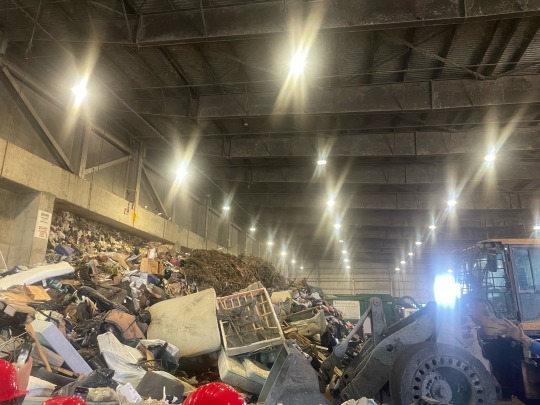


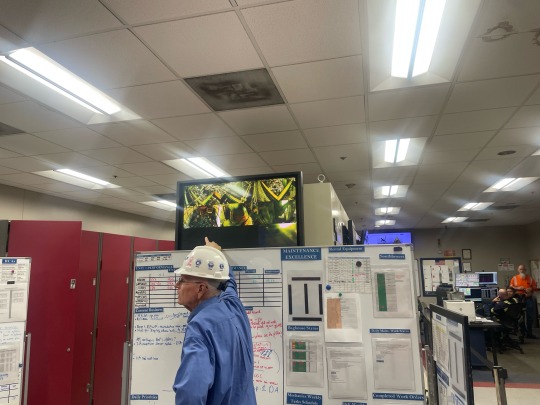

0 notes
Text
Biden’s State Department Needs a Reset
The administration’s diplomacy has underperformed—except at time-wasting talk about democracy.
— By Stephen M. Walt, a columnist at Foreign Policy and the Robert and Renée Belfer professor of international relations at Harvard University. FP subscribers can now receive alerts when new stories written by this author are published.
— April 01, 2023 | Foreign Policy

Newly confirmed US Secretary of State Antony Blinken speaks during a welcome ceremony at the State Department in Washington,DC on January 27, 2021. Carlos Barria/Pool/AFP Via Getty Images
It is a truth universally acknowledged that America’s diplomatic institutions—and especially the State Department—are under-resourced. This truth is especially evident when you compare the State Department or Agency for International Development budgets with the money allocated to the Defense Department or the intelligence services. It’s even more obvious when you take America’s lofty global ambitions into account. It’s also a truism that the president’s time—and that of top cabinet officials such as Secretary of State Antony Blinken—is the scarcest resource of all.
If this is the case, then why-oh-why did the Biden administration devote any time at all to a second Summit for Democracy? It’s not just the time that U.S. President Joe Biden, Blinken, and other senior officials devoted to this talkfest. Putting something like this together also burned up hundreds of hours of staff time that might have been used to address other problems.
I raise this issue because the Biden administration took office vowing to put diplomacy at the center of U.S. foreign policy, yet it has relatively few diplomatic achievements to show for its first two-plus years. On the plus side, U.S. allies are far more comfortable with Biden and Blinken than they were with former President Donald Trump and former Secretary of State Mike Pompeo, and they’ve been willing to forgive some of the administration’s early blunders (such as the unnecessary snub of the French during the AUKUS submarine deal in 2021). But apart from improved optics, the administration’s diplomatic record is unimpressive.
Part of the problem is the “democracy vs. autocracy” framing that Biden & Co. have embraced. I like democracy as much as anyone and more than some, but this dichotomy causes more problems for U.S. diplomacy than it solves. It doesn’t help the United States work more effectively with the autocratic governments that outnumber the world’s democracies and whose help may be more valuable as great power rivalries intensify. It leaves the United States exposed to accusations of hypocrisy, and it doesn’t seem to motivate Washington’s democratic allies very much. Case in point: European leaders keep traveling to Beijing to safeguard their economic interests with (autocratic) China, behavior sharply at odds with the democracy vs. autocracy template. Similarly, the president of (mostly) democratic India, Narendra Modi, just held talks with one of Russian President Vladimir Putin’s top national security advisors.
Meanwhile, other items on the administration’s agenda remain unfulfilled. Biden took office saying he’d rejoin the nuclear deal with Iran that his predecessor had foolishly left. But he dithered and delayed, Iran’s position hardened, and it is now clear that no new nuclear deal is forthcoming. The result? Iran is closer than ever to nuclear weapons capability, raising the risk of a Middle East war that neither the U.S. administration nor the world needs right now.
Making matters worse, Biden and Blinken have been repeatedly humiliated by their various Middle East allies. The Egyptian government routinely ignores U.S. human rights concerns while continuing to pocket U.S. economic aid. Biden reversed his campaign vow to make Saudi Crown Prince Mohammed bin Salman a pariah for the murder of dissident journalist Jamal Khashoggi, but the fist bump “seen ‘round the world” didn’t convince the Saudis to help ease energy prices or persuade them to put any pressure on Moscow after its invasion of Ukraine. More ominously, the Saudis keep moving closer to Chinese President Xi Jinping. Just this week, Saudi Aramco announced two new oil-related investment deals with China (including building a refinery there); and it was China—not the United States—that helped broker the recent détente between Saudi Arabia and Iran. I don’t blame either the Chinese or the Saudis for acting in their own interest, but it’s hard to see any of this as triumph of U.S. diplomacy.
Biden and Blinken aren’t directly responsible for the current crisis in U.S. relations with Israel—Israeli Prime Minister Benjamin Netanyahu’s “judicial reform” proposal deserves most of the blame for that—but their indulgent attitude toward Israel probably made Netanyahu think he could get away with it. Biden and Blinken have love-bombed Israel from the start: They didn’t reverse Trump’s decision to move the U.S. embassy to Jerusalem, failed to fulfill repeated promises to reopen a consulate for Palestinians, and offered only the usual mild expressions of “concern” at Israel’s continuing efforts to colonize the West Bank. Instead of distancing the United States from Israel’s increasingly worrisome conduct, Biden and Blinken kept repeating the usual cliches about the “ironclad” U.S. commitment and expressing their continued belief in a mythical creature: the two-state solution. No wonder Netanyahu thought he could move ahead with his controversial assault on Israeli democracy without jeopardizing U.S. support. And when Biden finally voiced some mild criticisms earlier this week, Netanyahu quickly responded by saying Israel would make its own decisions. That’s the kind of diplomatic influence that unconditional support buys you.
Meanwhile, the United States seems to be ceding its role as a global peacemaker. The country that once made arms control a top priority and brokered the Egyptian-Israeli peace treaty, the Good Friday Agreement, and an end to the Balkan Wars is less interested in ending conflicts than in helping its preferred side win, even when the end result is more death and destruction and a continued risk of escalation. As the Quincy Institute’s Trita Parsi noted last week, “America appears to have given up on the virtues of honest peacemaking. … Today, our leaders mediate to help ‘our’ side in a conflict advance our position rather than to establish a lasting peace.”

The Boak Bollocks of Fake Democracy Preacher will Preach About Democracy
U.S. diplomacy is falling short in dealing with China too. The administration’s mantra toward China, as expressed by Blinken in 2021, is that the United States “will be competitive when it should be, collaborative when it can be, and adversarial when it must be.” But the first and third items have taken center stage, and efforts to find common ground and manage an increasingly intense security rivalry have been few and far between. Some of the blame rests with Beijing, of course, but one sees few signs of creative thinking about how this critical bilateral relationship could be managed or improved.
It’s not all bad news: U.S. efforts to strengthen relations with existing Asian partners such as Japan and Australia have gone well, aided in no small part by China’s ill-considered assertiveness. But the Biden administration’s broader effort to weaken China by imposing export controls on advanced chips and subsidizing U.S. digital industries has also imposed significant costs on these same partners, while heightening Asian concerns about a future clash in their neighborhood. Nor has the Biden team been able to formulate an effective counter to China’s growing economic influence in the Indo-Pacific. Biden’s not to blame for Trump’s ill-considered decision to abandon the Trans-Pacific Partnership in 2017, but the administration’s substitute—the Indo-Pacific Economic Framework, which it finally rolled out last year—is widely and correctly seen as small potatoes by most of Asia.
One of the administration’s early diplomatic successes was Treasury Secretary Janet Yellen’s effort to negotiate a multilateral agreement for a global minimum tax on multinational corporations (thereby preventing them from avoiding taxes by declaring profits in low-tax offshore locations). Kudos for Yellen, but the measure now lies moribund in Congress and may never come into force. And the administration’s more successful domestic initiatives, most notably the Inflation Reduction Act, have created serious frictions with U.S allies that regard these measures as promoting U.S. industries at their expense.
“Hold on a minute,” I hear you say. What about the critical role that U.S. diplomacy played in organizing the Western response to Russia’s illegal invasion of Ukraine, not to mention those lopsided United Nations General Assembly votes condemning Moscow’s actions? Doesn’t that prove that America is back and its diplomats are doing their jobs with consummate skill?
Yes and no. On one hand, Biden and his team have led a coordinated Western response to the invasion, and this hasn’t always been easy. But it ain’t over till it’s over, and the ultimate result of this effort is uncertain. The cruel reality is that a protracted war that ends with Russia in control of some or all of the Donbass and Ukraine depopulated and heavily damaged will not look like a grand foreign-policy achievement. We all hope that does not happen, but it is certainly not an outcome one can rule out.
The sad fact is that the Biden administration has done an excellent job of responding to a problem that was at least partly of its own making. The roots of the Ukraine war predate Biden’s inauguration, but neither Biden nor Blinken saw the war coming soon enough. They did not recognize that Russia saw the trends in Ukraine as an existential threat, nor did they do everything they could have to head the war off. U.S. officials (both past and present) have gone to great lengths to deny that U.S. or Western policy played any role whatsoever in causing this tragedy, but a dispassionate look at the evidence—such as the recent account by British historian Geoffrey Roberts in the Journal of Military and Strategic Studies—shows otherwise. As I’ve put it before, “Putin is directly responsible for the war, but the West is not blameless.”
We will probably never know if the war could have been avoided had the United States and its European allies made a more serious and creative attempt to address Russia’s security concerns, and dropped their stubborn insistence that Ukraine would one day join NATO. I’m not letting Russia off the hook for starting a preventive war (an illegal act under international law) or for the way it has waged it. But when one thinks about the consequences of the war for the world—and for Ukraine most of all—the United States’ failure to do everything within reason to head it off deserves more critical scrutiny than it has received to date.
To be fair, the disappointing performance of the United States’ diplomats isn’t entirely their fault. Because America’s global ambitions are so vast, many problems won’t receive adequate attention, let alone command the time, energy, and commitment of the people at the very top. And the bigger and broader Washington’s goals, the harder it is to reconcile tradeoffs between them and maintain a clear and consistent set of priorities. This is one of the (many) reasons why some of us keep arguing for greater foreign-policy restraint: U.S. foreign policy would be more successful if it did less but did the vital things well.
Which brings me back to that Summit for Democracy. Even if one overlooks the inconsistent criteria for attendance and the peculiar optics of some troubled democracies (France, Israel, Brazil, India, the United States, etc.) getting together to extol democracy’s virtues, it’s not clear what will be gained from this effort. The first summit didn’t reverse the downward trends that have been underway for almost two decades, which makes one wonder what a second gathering will achieve. Assembling a bunch of powerful officials makes sense when there is something immediate and tangible that they can do together, which is why the Bretton Woods Conference in 1944, the Madrid Conference of 1991, or the 2015 Paris Climate Conference were worth doing. Similarly, the Obama administration’s four nuclear summits produced some tangible results—such as various agreements to improve custody over nuclear materials world-wide and reduce existing stockpiles of nuclear material—even if they did not reach every one of the administration’s initial objectives.
As near as I can tell, the democracy summits will fall well short of even those modest achievements. Democracy’s future is not going to be helped by more talkfests; it will depend on whether the world’s democracies can deliver better results for their citizens at home and abroad. Success will take a lot of work, and even the wealthiest democracies do not have infinite time or resources—which is why I hope the second Summit for Democracy is also the last.
0 notes
Text
Journal #7

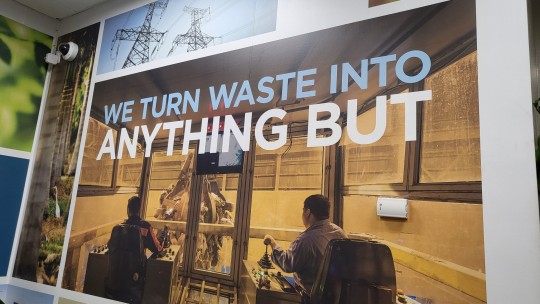
Picture #1 & #2 - Credit: Joanna Francisco-Castro - Entrance of the Lee County Waste to Energy Facility
We started off the tour of the Lee County Waste to Energy facility by meeting Mr. Tom, who acted as our guide and educator. He explained how Covanta partnered with Lee County to build the facility. A fact I found astonishing was that the day we visited the facility, they had 16,000 tons of trash the morning of. That's a large number, and I never really thought about how much the county accumulates in trash daily.

Picture #3- Credit: Joanna Francisco-Castro - Conference Room Education Session View
After that, we moved to a conference room on the 3rd floor for a quick education session. Here we learned that there are approximately 803,000 people in Lee county and 43,000 in Hendry county. An important term we learned during this time was single-stream recycling, when is when all recycles got into a single bin instead of it being separated. Mr. Tom also mentioned during this time that recycling should not be contaminated and not in bags. This made me reflect on a time when my family would put our recycling in bags because, at that time we weren't educated. Now we always make sure to reuse plastic bags in other ways and not to use them for recycling purposes.
We were also taught about the four main fuels, which are natural gas, coal, nuclear, and renewables. A fact that I was very happy to see was that coal was at 75% of the main fuels, but it is now at 20%. I believe that as we grew to be more environmentally conscious, we started changing the fuel we use since it causes air pollution. The four R's, which are reduce, reuse, recycle, and recover, were also taught to us. Of these four R's, I reuse the most because I love second-hand shopping. It gives me the opportunity to give an item a second chance instead of going to the landfill. I'm proud to say that approximately 70% of my clothing is bought second-hand!

Picture #4 - Credit: Joanna Francisco-Castro - Tour Picture of Waste
After the education session in the conference room, we were given a quick tour. It was overall very hard to hear because of how loud the areas were, but it was nonetheless interesting to see. I don't think I would have toured the facility if not for colloquium. I did find it interesting how Mr. Tom did explain the jobs because it's not as easy as it seems, considering they have to get certified by an official engineering organization. Unfortunately this trip, I did forget to take a selfie, but I was 100% in the group picture taken that day.
0 notes